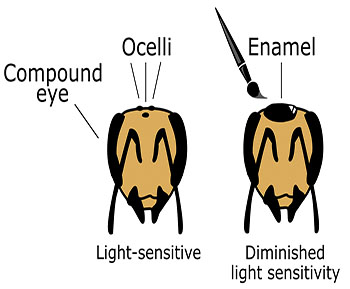
Last spring, I was walking through the blueberry fields at the University of British Columbia’s farm when I noticed something peculiar. We have a handful of research colonies near the edge of the blueberry patch, the blueberries were in full bloom, and the bushes were humming with activity. But it wasn’t the honey bees who were humming. It was the bumble bees.
Hardly any of our honey bees were on the clumps of pink and white blueberry bells. Our colonies live at the UBC farm year-round and weren’t placed there to pollinate, so we weren’t concerned about their lack of interest. But later that week, when I inspected the bushes at a large-scale blueberry farm with pallets of beehives brought in specifically for pollination, there weren’t many honey bees on those flower bells, either. And because there wasn’t much good bumble bee habitat, I spotted few bumbles, too.
Why weren’t the honey bees interested? Their lack of visitation creates a bit of a problem. We want the honey bees to pollinate our crops, because in an industrial agricultural setting there often aren’t enough native pollinators around. But for some plants, it’s a bit like trying to get your kid to eat spinach. The bees are reluctant to start foraging on the crop—there are tastier options around, and so they may explore other sources first, before visiting the flowers we want. Sometimes it’s because the flower shape isn’t great for honey bees. Sometimes it’s because the nectar reward isn’t up to snuff. Sometimes it’s because the flowers are on the outer, rather than the inner, branches of a tree. But could there be a way to make the spinach look more like ice cream?
Walter Farina, a professor at the University of Buenos Aires, Argentina, is in the midst of answering that question. He and his research group study foraging behavior in social insects, including the ants Camponotus mus and Linepithema humile, as well as stingless bees and honey bees. I learned about his work at his plenary lecture for the 2018 International Union for the Study of Social Insects (IUSSI) meeting in Guarujá, Brazil, where he told the story of how controversy over von Frisch’s waggle dance eventually led him and his team to develop an easy way to enhance the pollinating power of honey bees for specific crops, which they aptly dubbed “precision pollination.” They are able to train bees to forage on specific crops more efficiently, simply by feeding the colonies crop-scented syrup before moving them into the fields.
Today, von Frisch is an iconic name, but it hasn’t always been. In his 1927 book, The Dancing Bees, he famously decoded the waggle dance, describing how distance and direction were communicated by the length of the waggle (a one second waggle is approximately equal to 0.6 mi) and the angle of the waggle line relative to the vertical (which communicates the direction relative to the sun). We take that as common knowledge, now, but this straightforward interpretation was hotly debated as late as the 1960s, when other researchers criticized von Frisch’s work for not including proper controls in his experiments, and thus not being able to rule out the role of odor in navigation to forage sources.1,2 The smell of a floral source on the dancing bee and the nectar she shared could be sufficient to enable new recruits to find the source, they argued, especially if the source was nearby. Von Frisch himself even showed that foragers leave odor traces, or “scent marks” at nectar sources, which helps the new recruits locate it.
So, which is more important: the dance or the perfume? To find out, researchers have employed a series of clever tricks to disentangle the roles of distance, direction, and odor for finding foraging stations. When all the information points to the same forage source, it’s hard to know what element is most important. Researchers have gotten around this by deliberately making foragers give confusing signals to new recruits, where the dance points one way but their scent marks point another. If, for example, a dancer smells like the foraging station and leaves her odor cues there, but gives new recruits the wrong direction or distance information, and the recruits still find the forage, that suggests odor is playing an important role in navigation.
James Gould put this idea to the test in a well-designed experiment, which was published in Nature back in 1974.1 He set up a feeding station and waited for his bees to find it and begin dancing for new recruits. Then he shone a bright light inside the hive, which is known to confuse the bees and make them re-orient their waggle to the direction of the light, rather than to gravity. The recruits also re-orient how they interpret the waggle, resulting in no miscommunication. But if the dancer’s light-sensing eyes (the ocelli) are painted over, they don’t know the light is there and will still dance relative to the vertical. The recruits, whose ocelli are not painted, will interpret the waggle direction relative to the light in the hive. By controlling the angle of the light, Gould could control to what degree the recruits misinterpret the dancer’s directional information. So the dancers travel to and fro, visiting the foraging station, depositing scent marks, bringing back the flowers’ odor, and dancing their heart out to an audience of re-oriented recruits.
If the recruits were getting their location information from odor signals alone, it shouldn’t matter whether they misinterpret the dance angle – they should still arrive at the same scent-marked foraging station visited by the blinded dancers. However, if the dance angle dictates direction, the….


